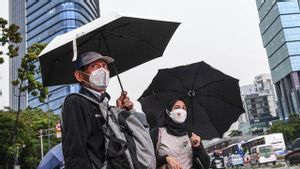JAKARTA - The COVID-19 pandemic has forced governments in many countries in the world to implement physical distancing or maintain distances between individuals. The most extreme is adopting a national lockdown policy. Automatically, activity in several countries is paralyzed.
The once congested city streets are now free. Highway traffic is light. There were fewer people hanging around outside. Seismological scientists observe that the impact of this paralyzed human activity is reduced seismic vibrations or what is called ambient seismic noise.
Seismologists say that the impact of the "resting" of the world is quite significant, so that ambient seismic noise is much less. This means that the vibrations on the earth generated by the movement of cars, trains, buses, and people carrying out their daily activities, make the upper crust move less.
As reported by CNN, a geologist and seismologist at the Royal Observatory of Belgium, Thomas Lecocq, showed this phenomenon for the first time in Brussels.
The city has seen an estimated 30 to 50 percent reduction in ambient seismic noise since mid-March, when the country began closing schools and business activities. Then what is the impact?
A sign
According to Lecocq and other seismologists, the impact of reduced ambient seismic noise is that they are able to detect earthquakes and other seismic events of lesser magnitude, which are usually difficult for certain seismic stations to record. Take Brussels, for example, where under normal circumstances observation stations were "of little use."
Seismic stations are usually built in areas outside urban areas. The goal, because human noise levels are lower, make seismic instruments pick up subtle vibrations on the ground.
The day-to-day buzz of city life will usually make it difficult to capture a smaller seismic event like the one in Brussels. To get around this, seismologists will rely on borehole seismic stations buried deep in the ground to monitor seismic activity.
"But now, as the city is calmer, (the seismic station) is almost as good as the one below," Lecocq was quoted as saying by CNN.
Brussels is not the only place experiencing such a phenomenon. British seismologist Paula Koelemeijer posted a graphic showing seismic noise in West London also decreased after schools and other places of social activity in the UK were closed. In addition, a similar phenomenon also occurred in Los Angeles.
How the seismic noise on our little @raspishake seismometer running in West London (Twickenham) has been affected by the # covid19UK lockdown. This is a month of data for station R091F. The average noise levels are down reflecting fewer trains, buses and cars. pic.twitter.com/WmJLmAO18k
- Paula Koelemeijer (@seismo_koel) March 31, 2020
Despite all these phenomena, the reduction in seismic vibrations on earth according to seismologists is a sign. It is a sign that this is a serious warning of a virus that has sickened more than one million people worldwide, and killed tens of thousands of people.
As Lecocq says this is evidence that people in many parts of the world have listened to warnings from the authorities to stay indoors and minimize outside activity as much as possible.
"From a seismologist's point of view, we can motivate people to say 'OK, people if you feel alone at home to carry out this physical distancing, we can say no. We can tell you that almost everyone is in the house. All people do the same thing, "he said.
And once again, this social distancing is done for the benefit of everyone.

The English, Chinese, Japanese, Arabic, and French versions are automatically generated by the AI. So there may still be inaccuracies in translating, please always see Indonesian as our main language. (system supported by DigitalSiber.id)













